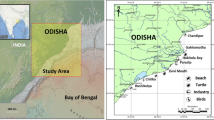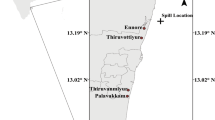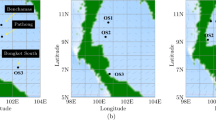Abstract
Numerical oil spill trajectory modelling aims at predicting and forecasting the movement of the oil spill. This paper discusses trajectory oil spill modelling for the hypothetical oil spills in the Bay of Bengal, off the Odisha coast. The models have been simulated in different locations of Odisha offshore for various weather conditions. The result showed that the northeast monsoon drives the slick faster than the southwest monsoon. A spill from 85 to 110 km away from the beach reached the coastline with higher speed in the cyclonic period. At the same time, the spill location at 70 km away from the coast could not reach the coast; this implies direction and speed of the wind and current play a critical role in spill movement. The fate budget of spill oil shows about 36% of evaporation happened in each case which shows that the period of spill and distance are not impacting the fate of oil. The direction of oil slick movement and speed are essential to understand the beaching of the oil pollutant at the shore. The study concluded that wind and ocean currents significantly influence oil spill movement.












Similar content being viewed by others
References
Abascal A J, Castanedo S, Medina R, Losada I J and Alvarez-Fanjul E 2009 Application of HF radar currents to oil spill modelling; Mar. Pollut. Bull. 58(2) 238–248.
Allan K F, Gary S and Douglas A 2014 Coats, status of intertidal infaunal communities following the Exxon Valdez oil spill in Prince William Sound, Alaska; Mar. Pollut. Bull. 84(1–2) 56–69.
Amir-Heidari P and Raie M 2019 A new stochastic oil spill risk assessment model for Persian Gulf: Development, application and evaluation; Mar. Pollut. Bull. 145 357–369.
Armenio E, Meftah M B, Padova D, Serio F and Mossa M 2019 Monitoring Systems and Numerical Models to Study Coastal Sites; Sensors (basel). 19(7) 1552, https://doi.org/10.3390/s19071552.
Azevedo A, Fortunato André B, Epifânio B, Boer S, Oliveira E R, Alves F L, Jesus G, Gomes J L and Oliveira A 2017 An oil risk management system based on high-resolution hazard and vulnerability calculations; Ocean Coast Manag. 136 1–18, https://doi.org/10.1016/j.ocecoaman.2016.11.014.
Balogun A-L, Matori A-N and Kiak K 2018 Developing an emergency response model for offshore oil spill disaster management using spatial decision support system; ISPRS Ann. Photogram. Remote Sens. Spat. Inf. Sci. 4 21–27.
Balogun A-L, Yekeen S T, Pradhan B and Wan Yusof K B 2021 Oil spill trajectory modelling and environmental vulnerability mapping using GNOME model and GIS; Environ. Pollut. 268(A), https://doi.org/10.1016/j.envpol.2020.115812.
Barker C H, Kourafalou V H, Beegle-Krause C, Boufadel M, Bourassa M A, Buschang S G, Androulidakis Y, Chassignet E P, Dagestad K-F, Danmeier D G, Dissanayake A L, Galt J A, Jacobs G, Marcotte G, Özgökmen T, Pinardi N, Schiller R V, Socolofsky S A, Thrift-Viveros D, Zelenke B, Zhang A and Zheng Y 2020 Progress in operational modelling in support of oil spill response; J. Mar. Sci. Eng. 8 668, https://doi.org/10.3390/jmse8090668.
Blackburn M C, Mazzacano A S, Fallon C and Black S H 2014 A review of the impacts of oil spills on marine invertebrates; The Xerces Society for Invertebrate Conservation, Portland, OR.
Cekirge H M, Koch M, Long C, Giammona C P, Binkley K, Engelhardt R and Jamail R 1995 State-of-the-art techniques in oil spill modelling; Int. Oil Spill Conf. Proc. 1 67–72, https://doi.org/10.7901/2169-3358-1995-1-67.
Chaitanya V S, Lengaigne M, Vialard J, Gopalakrishna V V, Durand F, Kranthikumar C, Amritash S, Suneel V, Papa F and Ravichandran M 2014 Salinity measurements collected by Fishermen reveal a ‘River in the Sea’ flowing along the eastern coast of India; Bull. Am. Meteorol. Soc. 95 1897–1908; https://doi.org/10.1175/BAMS-D-12-00243.1.
Chang S E, Stone J, Demes K and Piscitelli M 2014 Consequences of oil spills: A review and framework for informing planning; Ecol. Soc. 19(2) 26, https://doi.org/10.5751/ES-06406-190226.
Chang Y L, Oey L and Xu F H 2010 Oil spill: Trajectory projections based on ensemble drifter analyses; Ocean Dyn. 61 829–839, https://doi.org/10.1007/s10236-011-0397-4.
Chassignet E P, Hurlburt H E, Smedstad O M, Halliwell G R, Hogan P J, Wallcraft A J, Baraille R and Bleck R 2007 The HYCOM (HYbrid Coordinate Ocean Model) data assimilative system; J. Mar. Syst. 65(1) 60–83.
Farzingohar M, Zelina Z and Ibrahim Yasemi M 2011 Oil spill modelling of diesel and gasoline with GNOME around Rajaee Port of Bandar Abbas, Iran; Iran. J. Fish. Sci. 10(1) 35–46.
Indian Ocean Forecast System, Indian National Centre for Ocean Information Services, India. http://www.incois.gov.in/Incois/indofos_main.jsp, http://www.shiptraffic.net/2001/04/bay-of-bengal-ship-traffic.html.
Kankara R S, Arockiaraj S and Prabhu K 2016 Environmental sensitivity mapping and risk assessment for oil spill along the Chennai Coast in India; Mar. Pollut. Bull. 106(1–2) 95–103.
Keramea P, Spanoudaki K, Zodiatis G, Gikas G and Sylaios G 2021 Oil spill modeling: A critical review on current trends, perspectives, and challenges; J. Mar. Sci. Eng. 9(2) 181, https://doi.org/10.3390/jmse9020181.
Lee K, Boufadel M, Chen B, Foght J, Hodson P, Swanson S and Venosa A 2015 The behaviour and environmental impacts of crude oil released into aqueous environments; The Royal Society of Canada, Ottawa.
Li P, Cai Q, Lin W, Chen B and Zhang B 2016 Offshore oil spill response practices and emerging challenges; Mar. Pollut. Bull 110 6–27.
Liu X, Guo J, Guo M, Hu X, Tang C, Wang C and Xing Q 2015 Modelling of oil spill trajectory for 2011 Penglai 19–3 coastal drilling field China; Appl. Math. Model 39(18) 5331–5340.
Lopez J R, March R R, Gonzalez S G and Socias F S 2006 Simulation of oil spills at the Casablanca platform (Tarragona, Spain) under different environmental condition; J. Mar. Res. 3(1) 55–72.
Marta-Almeida M, Villarreal R, Pereira J, Otero P, Cirano M and Zhang X 2013 Efficient tools for marine operational forecast and oil spill tracking; Mar. Pollut. Bull. 71(1–2) 139–151.
Mearns A J, Bissell M, Morrison A M, Rempel-Hester M A, Arthur C and Rutherford N 2019 Effects of pollution on marine organisms; Water Environ. Res. 91(10) 1229–1252, https://doi.org/10.1002/wer.1218.
Mei H and Yin Y 2009 Studies on marine oil spills and their ecological damage; J. Ocean Univ. China 8 312–316, https://doi.org/10.1007/s11802-009-0312-5.
Metzger E J, Hurlburt H E, Wallcraft A J, Shriver J F, Townsend T L, Smedstad O M, Thoppil P G and Franklin D S 2009 Validation Test Report for the Global Ocean Prediction System V3.0 – 1/12° HYCOM/NCODA: Phase II; NRL Memo. Report., NRL/MR/7320-10-9236.
Metzger E J, Smedstad O M, Thoppil P G, Hurlburt H E, Cummings J A, Wallcraft A J and Zamudio L 2014 US Navy operational global ocean and Arctic ice prediction systems; Oceanography 27(3) 32–43, https://doi.org/10.5670/oceanog.2014.66.
Ministry of Petroleum and Natural Gas Economics & Statistics Division 2020 Indian Petroleum & Natural Gas Statistics 2018–2019; Government of India, https://mopng.gov.in/files/TableManagements/arep2020.pdf.
Mishra A K and Kumar G S 2015 Weathering of oil spill: Modelling and analysis; Aquat. Proc. 4 435–442.
Mishra P and Usha T 2011 Conserving the coastlines; geospatial TODAY, pp. 14–20.
Nagalaskhmi R, Premkumar G and Rameshwaran P M 2018 Assessments of an oil spill spreading in ennore coastal area using GNOME Open Source Software; J. Adv. Res. Dyn. Control Syst., pp. 1203–1205.
Naidu V S, Sukumaran S, Dubbewar O and Reddy G S 2013 Operational forecast of oil spill trajectory and assessment of impacts on intertidal macrobenthos in the Dahanu Region, west coast of India; J. Coast. Res. 29(2) 398–409, https://doi.org/10.2112/JCOASTRES-D-12-00071.1.
Nordam T, Beegle-Krause C J, Skancke J, Nepstad R and Reed M 2019 Improving oil spill trajectory modelling in the Arctic; Mar. Pollut. Bull. 140 65–74.
Panda S P, Mardaraj P, Subudhi H N and Sahu A K 2013 Biodiversity and conservation of mangroves of Devi River Estuary (Odisha), India; Int. J. Curr. Res. 5(10) 2751–2758.
Pradhan B, Das M and Pradhan C 2021 Forecasting oil spill movement through trajectory modelling: A case study from Bay of Bengal, India; Model. Earth Syst. Environ. 7 1107–1119, https://doi.org/10.1007/s40808-020-00933-4.
Prasad S J, Balakrishnan Nair T M, Francis P A and Vijayalaksmi T 2014 Hindcasting and validation of Mumbai oil spills using GNOME; Int. Res. J. Environ. Sci. 3(12) 18–27.
Prasad S J, Balakrishnan Nair T M, Hasibur R, Shenoi S S C and Vijayalakshmi T 2018 An assessment on oil spill trajectory prediction: Case study on oil spill off Ennore Port; J. Earth Syst. Sci. 127 111, https://doi.org/10.1007/s12040-018-1015-3.
Qiao F, Guansuo W, Liping Y, Kan Z, Yuanling Z, Min Z, Bin X, Shumin J, Haibo C and Ge C 2019 Modelling oil trajectories and potentially contaminated areas from the Sanchi oil spill; Sci. Total Environ. 685 856–866.
Rajapriyadharshini J R and Sudaliamani K 2017 Oil spill trajectory forecast with the aid of gnome; Res. J. Mar. Sci. 5(3) 1–6.
Remyalekshmi R and Hegde A V 2013 Numerical modelling of oil spill movement along north-west coast of India using GNOME; IJOCS 4(1) 75–86.
Rogowska J and Namieśnik J 2010 Environmental implications of oil spills from shipping accidents; Rev. Environ. Contam. Toxicol. 206 95–114, https://doi.org/10.1007/978-1-4419-6260-7_5.
Saadoun I M K 2015 Impact of oil spills on marine life; In: Emerging pollutants in the environment – current and further implications (eds) Marcelo L L and Sonia S, Intech Open, https://doi.org/10.5772/60455.
Singh S, Thattai D, Rangarajan S and Jaishree D 2019 Oil spill risk assessment study for Andaman and Nicobar Islands, India; AIP Conf. Proc. 2112 020026.
Soundarapandiyan K and Ganesh M 2017 An analytical view of crude oil prices and its impact on Indian economy; IOSR J. Business Manag. (IOSR-JBM) 2319–7668 23–28.
Toz A C and Buber M 2018 Performance evaluation of oil spill software systems in early fate and trajectory of oil spill: Comparison analysis of OILMAP and PISCES 2 in Mersin bay spill; Environ. Monit. Assess. 190 551, https://doi.org/10.1007/s10661-018-6872-3.
Toz A C and Koseoglu B 2018 Trajectory prediction of oil spill with Pisces 2 around Bay of Izmir, Turkey; Mar. Pollut. Bull. 126 215–227, https://doi.org/10.1016/j.marpolbul.2017.08.062.
Zafirakou A, Palantzas G, Samaras A and Koutitas C 2015 Oil spill modelling aiming at the protection of ports and coastal areas; Environ. Process. 2 S41–S53, https://doi.org/10.1007/s40710-015-0100-8.
Zelenke B C, O'Connor C B, Beegle-Krause C J and Eclipse L (eds) 2012 General NOAA Operational Modelling Environment (GNOME) Technical Documentation; U.S. Dept. of Commerce, NOAA Technical Memorandum NOS OR&R 40. Seattle, WA: Emergency Response Division, NOAA, 105p, http://response.restoration.noaa.gov/gnome_manual.
Acknowledgement
The authors wish to acknowledge the Department of Environmental Science, Utkal University, Odisha, for providing the support and facilities to help in the research program and field study.
Author information
Authors and Affiliations
Contributions
Binapani Pradhan is responsible for data collection, modelling, analysis and manuscript. Madhumita Das and Chinmay Pradhan are responsible for conceptualisation of the work. Binapani Pradhan, Madhumita Das, and Chinmay Pradhan are responsible for data generation and visualisation.
Corresponding author
Additional information
Communicated by Maripi Dileep
Rights and permissions
About this article
Cite this article
Pradhan, B., Das, M. & Pradhan, C. Trajectory modelling for hypothetical oil spill in Odisha offshore, India. J Earth Syst Sci 131, 205 (2022). https://doi.org/10.1007/s12040-022-01946-6
Received:
Revised:
Accepted:
Published:
DOI: https://doi.org/10.1007/s12040-022-01946-6




